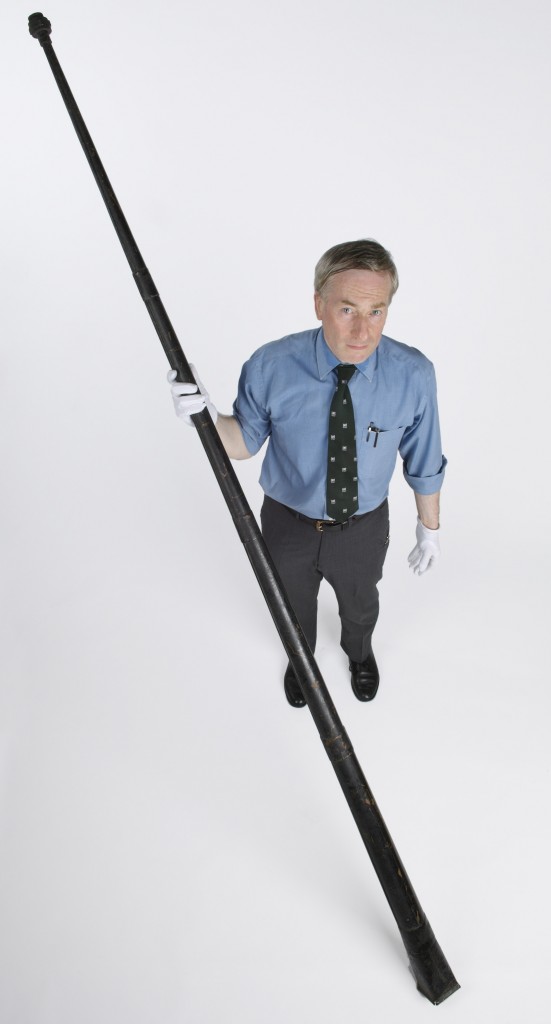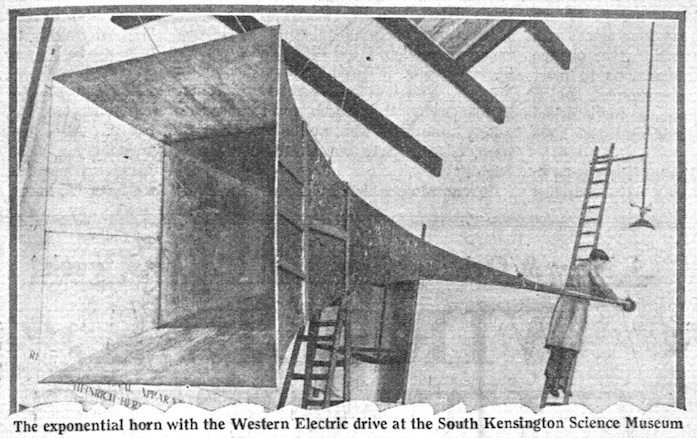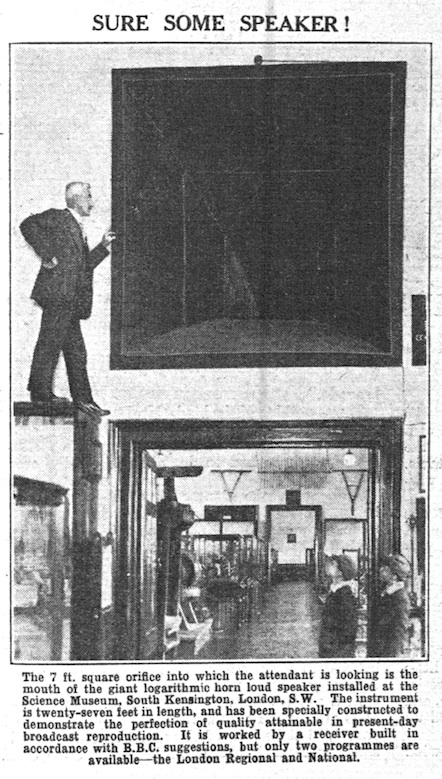
A long black metal tube, slightly tapered and almost 9-foot-long lay on a row of filing cabinets at Blythe House, the Science Museum’s storage facility.
The object was pointed out by John Liffen, the Museum’s Curator of Communications, who guided me during a research visit of the collections in 2008.
It was all that remained of a mighty horn loudspeaker that was demonstrated in the Museum during the 1930s, John explained. A demolition accident had almost totally destroyed it in 1949.
Now the tube assumed a more fascinating form, like a fossil or a dinosaur bone as we delved into audio archeology. The story of the horn, researched in great detail by John, sparked an interest in me. Four years later in 2012, on being appointed as the Museum’s first-ever sound artist-in-residence, I was given a wonderful opportunity to initiate its reconstruction.
The exponential horn loudspeaker was designed in 1929 by the Museum’s curator of ‘Electrical Communication’ R. P. G. Denman who also personally built a radio receiver to run in tandem with it.
The purpose of this new sound system was to provide the public with demonstrations of the highest quality broadcast sound that was obtainable at the time. Denman saw it as setting a benchmark for audio quality, his aim was, in his words “to provide a standard by which commercial apparatus could be judged”.
The horn measured 27 feet (8.23m) in length with a cross-section that curved exponentially from 1 1/16 inches (27mm) to a massive 7-foot-1-inch square (2.16m sq.) at the horn mouth.
The science and theory of how horns propagate sound had only begun to emerge in the mid-1920s. It was found that a horn with an exponential shape was the most effective means of converting the sound energy from high pressure, low-velocity vibrations produced at the narrow end of the horn, into low pressure, high-velocity vibrations at its mouth then radiated into the outside air.
However, in order to reproduce the lowest sounding frequencies, this type of horn has to be very long with a correspondingly large opening.

Denman, an expert on loudspeakers, specially designed the horn in order to reproduce frequencies as low as 32Hz and up to 6kHz. This was achieved by loading it to one of the latest moving-coil driver units from the Western Electric Company (U.S.A.) namely the WE 555W, widely used in cinema sound systems of the time and now considered to be one of the greatest loudspeaker drivers ever made.

From 1930 until the outbreak of WWII in 1939, the apparatus was demonstrated daily in the Museum’s Radio Communication gallery. The giant horn mouth appeared on the wall above the entrance while the rest of it hung conspicuously in the adjacent Agricultural Implements gallery. It was built into the Museum’s infrastructure and may be described as being its very first sound installation.
Concerts broadcast on the BBC’s London Regional programmes provided the content for the demonstrations. Critical reactions were positive and for audiences at the time, accustomed to limited bandwidth, interference, and distortion, the sound must have truly been a revelation. The Museum’s Radio gallery became a popular lunchtime destination, where sandwiches were cheerfully munched while listening to the classics or Wurlitzer cinema organ music, the audio reproduced in glorious full-range. It left an indelible impression on those who heard it, including John Liffen’s own uncle. Writing in the Audio Engineering Society Journal of April 1975, the audio experts Percy and Geoffrey L. Wilson opined that “no superior loudspeaker has to date been demonstrated in Britain”.

Fast-forward to 2014 and we have an opportunity to hear the horn again.
This is thanks in no small part to the magnificent efforts of the Museum’s Workshops who undertook the reconstruction project with gusto. The missing 18-feet of the horn was rebuilt over an intense 8-month period following Denman’s original specification, although fiber-glass was used in place of the original lead and tin alloy. Led by the Workshops manager Steve Long, the team has succeeded in recreating the single largest loudspeaker in Britain.

The programme for the upcoming installation is a mixture of past and present, allowing us to listen to the horn in old and new ways.
Archive material from the BBC will be heard alongside recent recordings made within the Science Museum. Resonance 104.4FM will be resident in the space, broadcasting live from the Museum, while lunchtime concerts via BBC Radio 3 will mirror the original demonstrations of the 1930s.
A series of events, including live music, poetry and performance will also showcase new works for the horn created by a variety of artists, writers, and radio programme-makers.
The title, “In Search of Perfect Sound”, refers to Roderick Denman’s quest for audio nirvana. Our modern ears may have become accustomed to high fidelity audio and surround sound, but the exponential horn, with its extraordinary sound presence and a distinct three-dimensional effect, still holds an immersive power of its own.
I’m very proud to have played a part in giving the Denman horn a new lease of life and to have witnessed its exponential metamorphosis, from that modest-looking metal tube, cocooned above all those filing cabinets.
Aleks Kolkowski is a sound artist, violinist, and composer with a special interest in early sound recording and reproduction technology.
The Exponential Horn: In Search of Perfect Sound opened at the Media Space Studio on 20 May 2014.
4 comments on “In Search Of Perfect Sound”
Comments are closed.
Very interesting. It reminds me of my involvement in 500 Watt loudspeakers and a 1k Watt loudspeaker in my Tannoy days. We made some interesting and successful line source loudspeakers, which were pretty large including Dungeness Light House itself.
I remember seeing a similar demonstration in Manchester at an Association of Public Address Engineers day out in 1958 or 195 9 (APAE now replaced by I.S.C.E.)). Whilst the horn was not quite as long being about 10 or 12 feet it used an ear piece which was popular for small portable radios of the era to demonstrate the effective properties of a good exponential horn of not only good quantity but also efficiency. The demonstration was given by I believe someone from Manchester University. I have always believed in good horns and used them ever since in my public address work.
I was wondering if it would be possible to see a measurement of this wonderful horn.
Does it really go to 32Hz? Thank you for bringing this great horn back to life.
Hi Bill, Thanks for the question. The Exponential horn is 27ft long and has a frequency response of 32Hz – 6kHz. There’s more information about the horn here https://www.sciencemuseum.org.uk/exponentialhorn.